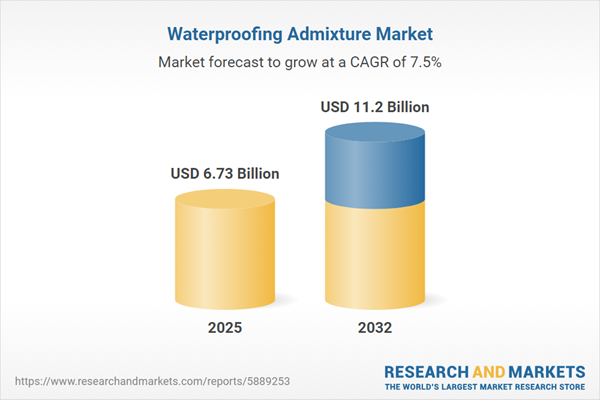Speak directly to the analyst to clarify any post sales queries you may have.
Senior stakeholders in the construction sector are increasingly adopting waterproofing admixtures as essential materials to deliver resilient and sustainable buildings. This report analyzes current market dynamics, encompassing innovation, regulatory influence, and global supply factors shaping procurement and strategic investment.
Market Snapshot: Waterproofing Admixture Market Overview
The waterproofing admixture market grew from USD 6.26 billion in 2024 to USD 6.73 billion in 2025. Sustained by robust demand in new construction and infrastructure revitalization, the sector is expected to expand at a CAGR of 7.53%, reaching USD 11.20 billion by 2032. Growth is supported by rising urbanization, stringent regulatory environments, and the increasing complexity of building performance needs.
Scope & Segmentation of the Waterproofing Admixture Market
This report provides detailed segmentation to help leaders assess product positioning and regional demand shifts. Covered divisions include:
- Type: Crystalline (hydrophilic, hydrophobic) and pore-blocking admixtures.
- Application: Basement (above grade, underground), parking structures (indoor, outdoor), roof (flat, pitched), and tunnel (bored, cut and cover) contexts.
- End Use: Commercial, industrial, and residential sectors.
- Form: Liquid (concentrate, ready to use) and powder (pre-blended, requiring additive).
- Regions: Americas (United States, Canada, Mexico, Brazil, Argentina, Chile, Colombia, Peru), Europe (including United Kingdom, Germany, France, Italy, Spain, Russia, Netherlands, Sweden, Poland, Switzerland), Middle East (UAE, Saudi Arabia, Qatar, Turkey, Israel), Africa (South Africa, Nigeria, Egypt, Kenya), and Asia-Pacific (China, India, Japan, Australia, South Korea, Indonesia, Thailand, Malaysia, Singapore, Taiwan).
- Key Companies: Sika AG, MAPEI S.p.A., BASF SE, GCP Applied Technologies Inc., MBCC Group GmbH, Arkema S.A., Chryso SAS, Fosroc International Limited, Solvay SA, RPM International Inc.
Key Takeaways for Decision-Makers
- Advanced admixture chemistries now extend far beyond water resistance, supporting longer structural life and improved energy efficiency.
- Sustainability pressures drive innovation in eco-friendly formulations using bio-based and recyclable materials to meet green building mandates.
- Digital platforms, including BIM integration and smart sensors, are streamlining specification, performance monitoring, and lifecycle management.
- Cross-industry partnerships enable multi-functional admixtures that deliver waterproofing alongside corrosion inhibition and thermal performance.
- Procurement teams benefit from tailored solutions: commercial projects may require extended durability, whereas residential builds emphasize cost-effective application.
- Logistics planning remains a critical differentiator, with on-site mixing preferences and product form factor—liquid or powder—shaping timely delivery and reduced complexity.
Tariff Impact: Navigating 2025 Trade Shifts
Recent United States tariff adjustments have realigned global supply chains, affecting sourcing strategies for key raw materials. Importers are increasingly turning to alternative domestic and tariff-exempt suppliers to manage costs and secure steady inventories. Adjustments include new warehousing strategies and changes in logistical routing to minimize delays and cost fluctuations. Companies have invested in enhanced compliance systems to address evolving customs and regulatory documentation for waterproofing admixture imports.
Methodology & Data Sources
The insights in this report result from comprehensive secondary research across industry publications, regulations, and peer-reviewed journals. Primary data was gathered through structured interviews and surveys with key market participants, including R&D, technical, and procurement leaders. Data triangulation and validation processes, supplemented by expert workshops and peer reviews, ensure the highest accuracy and actionable intelligence for senior business leadership.
Why This Report Matters for Waterproofing Admixture Strategies
- Supports risk mitigation and agility in a sector influenced by regulatory, technological, and trade shifts.
- Helps refine procurement and product portfolio strategies with targeted insight into application demands, sustainability trends, and regional growth engines.
- Provides competitors’ benchmarks and partnership opportunities to fuel innovation and operational resilience.
Conclusion
Integrating advanced waterproofing admixtures is central to meeting modern construction’s performance and sustainability expectations. This research delivers critical analysis to help decision-makers navigate complex markets and position for long-term, value-driven growth.
Additional Product Information:
- Purchase of this report includes 1 year online access with quarterly updates.
- This report can be updated on request. Please contact our Customer Experience team using the Ask a Question widget on our website.
Table of Contents
3. Executive Summary
4. Market Overview
7. Cumulative Impact of Artificial Intelligence 2025
Companies Mentioned
The companies profiled in this Waterproofing Admixture market report include:- Sika AG
- MAPEI S.p.A.
- BASF SE
- GCP Applied Technologies Inc.
- MBCC Group GmbH
- Arkema S.A.
- Chryso SAS
- Fosroc International Limited
- Solvay SA
- RPM International Inc.
Table Information
| Report Attribute | Details |
|---|---|
| No. of Pages | 196 |
| Published | October 2025 |
| Forecast Period | 2025 - 2032 |
| Estimated Market Value ( USD | $ 6.73 Billion |
| Forecasted Market Value ( USD | $ 11.2 Billion |
| Compound Annual Growth Rate | 7.5% |
| Regions Covered | Global |
| No. of Companies Mentioned | 11 |









